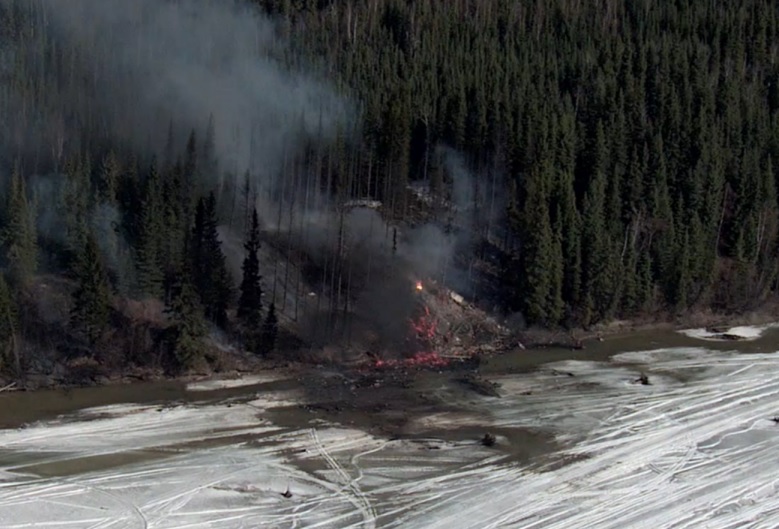
Federal investigators say the fuel-laden cargo plane that crashed and burned along the Tanana River late last month near Fairbanks lost a burning engine in the moments before impact.
The National Transportation Safety Board issued its preliminary report Thursday on the April 23 crash of the Kobuk-bound flight, which killed both crew members.
Alaska State Troopers spokesman Austin McDaniel said Thursday that the victims haven’t yet been named, as medical examiners continue work to positively identify their remains.
Clint Johnson, the NTSB’s Alaska chief, said aircraft operator Alaska Air Fuel has been highly cooperative with the investigation.
“We’re working hand in hand,” Johnson said. “They have a keen desire to figure out what happened here as well, and we’re using that expertise to be able to further our investigation.”
According to the report, the four-engine Douglas C-54 – a version of the World War II-era DC-4 airliner produced as a military transport – took off from Fairbanks International Airport at 9:55 a.m. on April 23. It was carrying 3,400 gallons of fuel oil and two 100-gallon propane tanks.
Soon afterward, a witness saw that the propeller plane’s No. 1 engine – the outermost engine on the plane’s port wing – was not operating.
“The witness also noticed a small, white plume of smoke coming from that engine,” NTSB officials said in the report. “The witness reported the airplane began a turn to the south at which point he noticed the engine was on fire.”
Johnson emphasized that the investigation is in its early phases. Investigators have not yet determined how or where the fire started, but Johnson said the engine is their main focus.
“We don’t know if it was the engine itself, or if that was maybe the fuel cells behind that or someplace on the firewall,” he said. “But obviously, that’s a key piece of evidence that we were lucky to get.”
Several witnesses in the area, about seven miles south of the Fairbanks airport, saw the plane go down. Farmer Mike Emers told Fairbanks public radio station KUAC that the C-54 passed above his field just before it crashed, in a moment captured by his doorbell camera.

“Recovered surveillance video shows white smoke behind the number one engine, followed by flames,” investigators said. “The video also revealed that seconds later a bright white explosion is seen just behind the number one engine followed by fragments of airplane wreckage falling to the ground.”
The plane’s pilots reported “a fire on board” in radio calls to Fairbanks air traffic controllers, and requested a return to the airport, according to the report. Radar data showed the plane heading southwest and west, then making a left turn back toward the airport just before its signal disappeared.
“The No. 1 engine separated from the wing about 100 (feet) above the ground and eventually came to rest on the frozen Tanana River,” investigators said.
A fire after the crash “incinerated much of the airplane’s structure,” investigators said in the report. But Johnson said the No. 1 engine was recovered, with a close examination of it pending.
“It’s back in Wasilla, and we’re getting a plan together to be able to look at that engine in a very elaborate laboratory-type environment,” he said.
Johnson said the NTSB will send an engine specialist from Washington, D.C. to help examine the Pratt & Whitney 2000-series radial engine, with help from Alaska Air Fuel staff.
Read the report below:
Chris Klint is a web producer and breaking news reporter at Alaska Public Media. Reach him at cklint@alaskapublic.org. Read more about Chris here.





